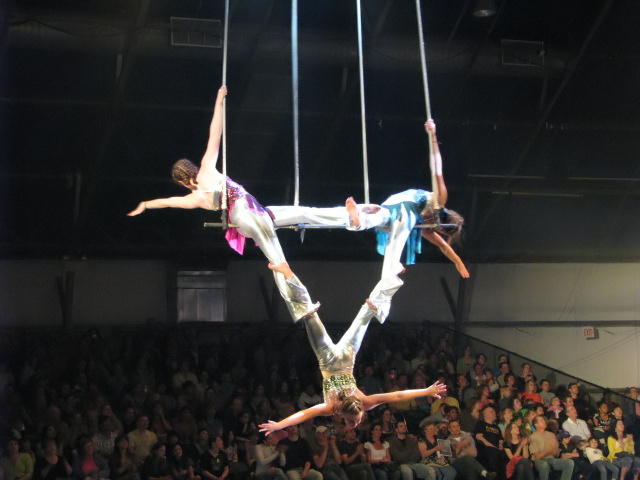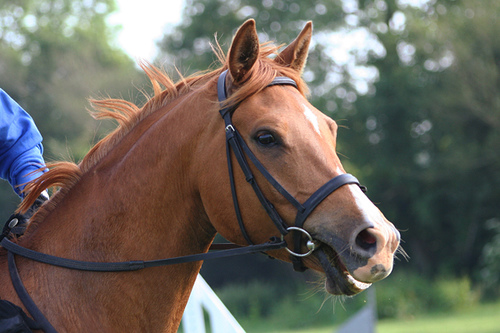|
Iron Jaw (circus)
The Iron Jaw is a traditional aerial circus act. The act consists of a performer raised into the air by a cable, trapeze or other similar apparatus, supported only by a bit clamped between her teeth. Depending on the apparatus the bit is attached to, the performer can alternately swing in circles around the ring below or spin wildly in place, controlling speed by alternately extending her arms and legs out or bringing them in close to her body to speed up (known as the conservation of angular momentum principle). The act is frequently referred to as the Human Butterfly due to the removable wings which traditionally adorn the performer's costume. It is also known as the 'Jaws of Life'. Tiny Kline, in a footnote to her memoir, describes Iron Jaw as: "(a) holding one's grip by the teeth bulldog-fashion, suspended in the air; (b) lifting another person's weight; (c) juggling furniture or tugging an automobile- in short, any work involving teeth-power." Notable performers * L ... [...More Info...] [...Related Items...] OR: [Wikipedia] [Google] [Baidu] |
Circus
A circus is a company of performers who put on diverse entertainment shows that may include clowns, acrobats, trained animals, trapeze acts, musicians, dancers, hoopers, tightrope walkers, jugglers, magicians, ventriloquists, and unicyclists as well as other object manipulation and stunt-oriented artists. The term ''circus'' also describes the performance which has followed various formats through its 250-year modern history. Although not the inventor of the medium, Philip Astley is credited as the father of the modern circus. In 1768, Astley, a skilled equestrian, began performing exhibitions of trick horse riding in an open field called Ha'Penny Hatch on the south side of the Thames River, England. In 1770, he hired acrobats, tightrope walkers, jugglers and a clown to fill in the pauses between the equestrian demonstrations and thus chanced on the format which was later named a "circus". Performances developed significantly over the next fifty years, with large-scale theat ... [...More Info...] [...Related Items...] OR: [Wikipedia] [Google] [Baidu] |
Spelterini LeonaDare
Eduard Spelterini (2 June 1852 – 16 June 1931) was a Swiss pioneer of ballooning and of aerial photography. Early life Spelterini was born in Bazenheid in the Toggenburg area in Switzerland as Eduard Schweizer.Degen, p. 39. His father, Sigmund Schweizer, was an innkeeper.Capus, p. 38. When he was eight years old, the family reportedly moved to northern Italy, to a place near the Swiss-Italian border in the province of Como. Eduard is said to have attended the schools in Lugano.Degen, p. 41. At the age of eighteen, Eduard allegedly went first to Milan and then to Paris to be trained as an opera singer. During this time, he chose the name "Spelterini", because to him it sound fancier than "Schweizer". His singing career was cut short by a severe case of pneumonia.Capus, p. 38, wrote in 2007 that he could not verify this sequence of events, but he couldn't disprove it either. He mentions an alternate version, based on the oral account of another balloon pilot who had known ... [...More Info...] [...Related Items...] OR: [Wikipedia] [Google] [Baidu] |
Trapeze
A trapeze is a short horizontal bar hung by ropes or metal straps from a ceiling support. It is an aerial apparatus commonly found in circus performances. Trapeze acts may be static, spinning (rigged from a single point), swinging or flying, and may be performed solo, double, triple or as a group act. The name of the apparatus reflects the trapezoid shape made by the horizontal bar, ropes and ceiling support. History The art of trapeze performance is reported to have been developed by Jules Léotard, a young French acrobat and aerialist, in Toulouse in the mid-1800s. He is said to have used his father's swimming pool to practice. However, the name "trapeze" can be found in books dating as far back as twenty years earlier, before Léotard was born. One such example is George Roland’s “An Introductory Course of Modern Gymnastic Exercises”, published in 1832. Roland proposes the idea that the trapeze might owe its origin to Colonel Amoros, but ultimately deems the questio ... [...More Info...] [...Related Items...] OR: [Wikipedia] [Google] [Baidu] |
Bit (horse)
The bit is an item of a horse's tack. It usually refers to the assembly of components that contacts and controls the horse's mouth, and includes the shanks, rings, cheekpads and mullen, all described here below, but it also sometimes simply refers to the ''mullen'', the piece that fits inside the horse's mouth. The mullen extends across the horse's mouth and rests on the ''bars'', the region between the incisors and molars where there are no teeth. The bit is located on the horse's head by the , and which has itself several components to allow the most comfortable adjustment of bit location and control. The bit, bridle and reins function together to give control of the horse's head to the rider. The bit applies pressure to the horse's mouth, and reinforces the other control signals from the rider's legs and weight distribution. A well schooled horse needs little pressure on the bit from a skilled rider. Studies have indicated that soft, consistent bit contact between the rider ... [...More Info...] [...Related Items...] OR: [Wikipedia] [Google] [Baidu] |
Conservation Of Angular Momentum
In physics, angular momentum (rarely, moment of momentum or rotational momentum) is the rotational analog of linear momentum. It is an important physical quantity because it is a conserved quantity—the total angular momentum of a closed system remains constant. Angular momentum has both a direction and a magnitude, and both are conserved. Bicycles and motorcycles, frisbees, rifled bullets, and gyroscopes owe their useful properties to conservation of angular momentum. Conservation of angular momentum is also why hurricanes form spirals and neutron stars have high rotational rates. In general, conservation limits the possible motion of a system, but it does not uniquely determine it. The three-dimensional angular momentum for a point particle is classically represented as a pseudovector , the cross product of the particle's position vector (relative to some origin) and its momentum vector; the latter is in Newtonian mechanics. Unlike linear momentum, angular mom ... [...More Info...] [...Related Items...] OR: [Wikipedia] [Google] [Baidu] |
Tiny Kline
Tiny Kline (born Helén Deutsch,Kline, Tiny. (2008). ''Circus Queen and Tinker Bell: The Memoir of Tiny Kline''. Edited by Janet M. Davis. University of Illinois Press. June 21, 1891 - July 5, 1964) was a Hungarian-bornTinker Bell bio on MousePlanet. Retrieved on 2009-10-14. performer. She performed with Ringling Bros. and Barnum & Bailey and as Tinker Bell at . Kline's most well-known act was the "slide for life," a variation of traditional [...More Info...] [...Related Items...] OR: [Wikipedia] [Google] [Baidu] |
Leona Dare
Leona Dare (1854/55 – May 23/24, 1922''New York Times'', May 25, 1922.) was an American trapeze artist and aerial acrobat, billed often as the "Queen of the Antilles" or the "Pride of Madrid".''New York Times'', June 9, 1879. She was famous for her stunts on trapezes suspended from ascending balloons. Leona Dare's real name was Susan Adeline Stuart or Stewart. Her teachers in acrobatics were the Hall brothers, Thomas and Stewart Hall, who were sometimes billed as the "Brothers Dare". In 1871, she married Thomas Hall''New York Times'', November 26, 1880Tait, p. 159, claims the Hall brothers were named Thomas and George, and that there were conflicting newspaper reports about whom of the two she married. in New Orleans or in New York City (sources disagree). The same year, she debuted as an artist at Nixon's Amphitheatre in New York City;Slout, p. 70. a year later, she was with the circus of Joel E. Warner. Her specialty was the " iron jaw" act, in which she held ont ... [...More Info...] [...Related Items...] OR: [Wikipedia] [Google] [Baidu] |
Miss La La
Miss La La (born April 21, 1858) was an expert aerialist who served as muse to Edgar Degas and was depicted in his 1879 painting ''Miss La La at the Cirque Fernando''. She was also depicted in a poster for the Folies Bergère. She was the star of Troupe Kaira, a traveling circus act, and performed with the Cirque Fernando, based in Montmartre. Early life La La was born either Anna Olga Albertina Brown or Olga Brown in the former German/Prussian territory of Szczecin to a black father and white mother. Career La La began touring as a child, approximately around age nine, when her mother placed her in the circus. She used multiple stage names throughout her career including Olga the Negress, Venus of the Tropics, African Princess, and Olga the Mulatto. She was also billed as La Femme Canon, La Mulatresse-Canon, and Black Venus. She played venues such as the Folies Bergère in Paris, the Royal Aquarium in London, and the Gaiety Theatre in Manchester. With Troupe Kaira, La La perf ... [...More Info...] [...Related Items...] OR: [Wikipedia] [Google] [Baidu] |
Nik Wallenda
Nikolas Wallenda (born January 24, 1979) is an American acrobat, aerialist, daredevil, high wire artist, and author. He is known for his high-wire performances without a safety net. He holds 11 Guinness World Records for various acrobatic feats, and is best known as the first person to walk a tightrope stretched directly over Niagara Falls. Wallenda walked 1,800 feet on a steel cable over Masaya Volcano in Nicaragua, his longest walk, on March 4, 2020. Wallenda is a 7th-generation member of The Flying Wallendas family, and he participated in various circus acts as a child. He made his professional tightrope walking debut at age 13, and he chose high-wire walking as his career in 1998 after joining family members in a seven-person pyramid on the wire. In 2001, he was part of the world's first eight-person high-wire pyramid. He performed with his family at various venues from 2002 to 2005, forming his own troupe in 2005. He performed with Bello Nock in 2007 and 2008 in a double v ... [...More Info...] [...Related Items...] OR: [Wikipedia] [Google] [Baidu] |





